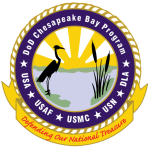2014 Chesapeake Bay Watershed Agreement
The 2014 Chesapeake Bay Watershed Agreement, with Executive Order 13508, guides the overall management of the DoD CBP. These documents establish long-term Goals for protection and restoration of the Bay, and time-bound, measurable Outcomes that directly contribute to achieving those Goals. Issues central to improving the Bay’s health include sustaining Abundant Life, restoring Clean Water, Conserving Land, Engaging Communities, and addressing Climate Change.
This plan established goals and outcomes for the restoration of the Bay, its tributaries and the lands that surround them, including:
Restoring Clean Water
-
Water Quality Goal
Reduce pollutants to achieve the water quality necessary to support the aquatic living resources of the Bay and its tributaries and protect human health.
-
Toxic Contaminants Goal
Ensure that the Bay and its rivers are free of effects of toxic contaminants on living resources and human health.
-
Healthy Watersheds Goal
Sustain state-identified healthy waters and watersheds recognized for their high quality and/or high ecological value.
Recovering Habitat
-
Vital Habitats Goal
Restore, enhance, and protect a network of land and water habitats to support fish and wildlife, and to afford other public benefits, including water quality, recreational uses, and scenic value across the watershed.
Sustaining Fish and Wildlife
-
Sustainable Fisheries Goal
Protect, restore, and enhance fish, shellfish, and other living resources, their habitats and ecological relationships to sustain all fisheries and provide for a balanced ecosystem in the watershed and Bay.
Conserving Land and Providing Public Access
-
Land Conservation Goal
Conserve landscapes treasured by citizens in order to maintain water quality and habitat; sustain working forests, farms, and maritime communities; and conserve lands of cultural, indigenous, and community value.
-
Public Access Goal
Expand public access to the Bay and its tributaries through existing and new local, state, and federal parks, refuges, reserves, trails, and partner sites.
Engaging Communities
-
Stewardship Goal
Increase the number and the diversity of local citizen stewards and local governments that actively support and carry out the conservation and restoration activities that achieve healthy local streams, rivers, and a vibrant Chesapeake Bay.
-
Environmental Literacy Goal
Enable every student in the region to graduate with the knowledge and skills to act responsibly to protect and restore their local watershed.
Increasing Resilience to Climate Changes
-
Climate Resiliency Goal
Increase the resiliency of the Chesapeake Bay watershed, including its living resources, habitats, public infrastructure, and communities, to withstand adverse impacts from changing environmental and climate conditions.
Executive Order 13508
Executive Order 13508 calls for the Federal Government to lead the effort in protecting and restoring the Chesapeake Bay watershed. As a landholder and a member of the Bay community, DoD is committed to restoring and protecting the Chesapeake Bay and its watershed and has established a joint service DoD Chesapeake Bay Program.
Advancing the 2014 Chesapeake Bay Watershed Agreement
In Fiscal Year (FY) 2020, DoD invested approximately $128 million (M) to restore the Chesapeake Bay. These efforts advance the goals and outcomes of the Chesapeake Bay Watershed Agreement and further the ability for DoD to test, train, and operate in the watershed. The DoD CBP also continues to support and coordinate initiatives to integrate restoration, pollution prevention, and stewardship in DoD’s daily mission; to engage DoD military and civilian employees and their families as stewards of the Chesapeake Bay; and to partner with federal, state, and local governments and organizations to maximize resources.


